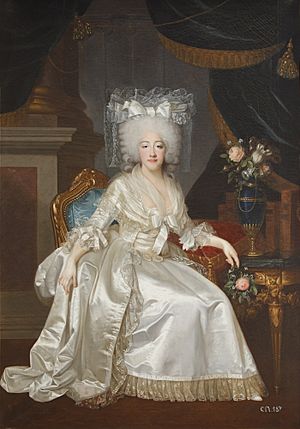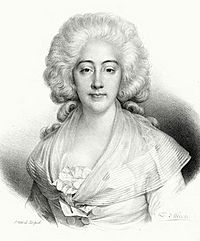Marie Joséphine of Savoy facts for kids
Quick facts for kids Marie Joséphine of Savoy |
|||||
|---|---|---|---|---|---|
| Countess of Provence | |||||

Portrait by Joseph Boze, 1786
|
|||||
| Queen consort of France (wife of claimant) | |||||
| Tenure | 8 June 1795 – 13 November 1810 | ||||
| Born | 2 September 1753 Royal Palace of Turin, Turin |
||||
| Died | 13 November 1810 (aged 57) Hartwell House, Buckinghamshire, England |
||||
| Burial |
|
||||
| Spouse | |||||
|
|||||
| House | Savoy | ||||
| Father | Victor Amadeus III of Sardinia | ||||
| Mother | Maria Antonia Ferdinanda of Spain | ||||
| Religion | Roman Catholicism | ||||
| Signature | |||||
 |
|||||
Marie Joséphine of Savoy (born September 2, 1753 – died November 13, 1810) was a princess from the House of Savoy. She became the Countess of Provence by marrying Louis Stanislas, who would later become Louis XVIII of France.
Even though she was called the 'Queen of France' by some royal supporters after her husband claimed the title in 1795, she never actually ruled as queen. This is because she passed away before her husband officially became King of France in 1814.
Contents
Early Life and Royal Marriage (1753–1773)
Marie Joséphine was born at the Royal Palace of Turin on September 2, 1753. She was the third child of Prince Victor Amadeus of Savoy and Infanta Maria Antonia Ferdinanda of Spain. At the time, her grandfather, Charles Emmanuel III, was the King of Sardinia.
Her brothers later became the last three kings of Sardinia from their family line. These were Charles Emmanuel IV, Victor Emmanuel I, and Charles Felix.
Arranged Marriage to a French Prince
Marie Joséphine was engaged to the French prince Louis Stanislas, who was the Count of Provence. This marriage was seen as a good match because of her family's royal connections.
The wedding took place twice. First, it was a proxy marriage on April 16, 1771, in the Kingdom of Sardinia. Then, the main ceremony happened in person on May 14, 1771, at the Palace of Versailles in France. After the proxy wedding in Turin, she traveled to France. She was welcomed by her new French staff at the border.
Her marriage was part of several royal weddings between the French and Savoyard families. Her younger sister, Maria Theresa of Savoy, married Louis Stanislas's younger brother, the Count of Artois (who later became King Charles X of France) in 1773. Also, her eldest brother, Prince Charles Emmanuel of Savoy, married her sister-in-law Princess Clotilde of France in 1775.
When her husband's grandfather, Louis XV, passed away in 1774, her brother-in-law became Louis XVI. As the king's older brother, her husband was then known as Monsieur. Marie Joséphine was therefore called Madame.
Countess of Provence (1773–1791)
Marie Joséphine's marriage was important because the king's older brother, the Dauphin, had not yet had children. This meant that the Count of Provence and Marie Joséphine might be the ones to provide the next heir to the throne.
When she arrived in France, Marie Joséphine was described as shy and not used to the fancy customs of the Versailles court. She was encouraged to adapt to French fashion and customs.
Her husband, Louis Stanislas, often talked about their marriage to show that they were having children. However, their marriage remained childless. Marie Joséphine had two pregnancies, one in 1774 and another in 1781, but both ended in miscarriage.
In their early years, Marie Joséphine and her husband, along with the other royal couples, enjoyed spending time together. They would go on sleigh rides, attend masquerades, and perform in amateur plays. As the second most important lady at court after the queen, Marie Joséphine often joined Marie Antoinette for official events.
However, after Louis XVI became king in 1774, the relationship between the royal couples became strained. Louis XVI and Louis Stanislas often argued. Marie Joséphine and her husband did not have children, and she did not have much political power. She was known to be intelligent and enjoyed reading.
After a few years, Marie Joséphine and her husband lived mostly separate lives. Marie Joséphine preferred to spend her time at her private villa, the Pavillon Madame in Montreuil. She spent a lot of money on it, building a beautiful garden with a music pavilion and a small village.
The French Revolution Begins
Unlike her sister and brother-in-law, who left France after the Storming of the Bastille in July 1789, Marie Joséphine and her husband stayed in France when the revolution began. They were at the Palace of Versailles during The Women's March on Versailles on October 5, 1789.
After the march, they had to move to Paris with the rest of the royal family. While the king and queen stayed at the Tuileries Palace, Marie Joséphine and her husband lived at the Luxembourg Palace, which was their usual home in Paris. They often visited the Tuileries Palace for family dinners.
By November 1790, the Count of Provence began planning for him and Marie Joséphine to leave France. Their escape was planned carefully to happen at the same time as the king and queen's departure. Marie Joséphine was not told all the details of the plan, but her close companion was informed to help with her arrangements.
In June 1791, Marie Joséphine and her husband successfully escaped to the Austrian Netherlands. This happened during the same time as the royal family's failed attempt to escape, known as the Flight to Varennes. Marie Joséphine left with her companion in one carriage, while her husband left in a different one. Their escape was more successful because they traveled separately and quietly. They both crossed the border without any problems and met up again in Namur.
Life in Exile and Passing (1791–1810)
From Namur, Marie Joséphine joined her husband in Brussels, where they met with the Count of Artois. They then traveled through Bonn to Koblenz, where their uncle, the Arch Bishop-Elector, offered them the Palace of Schönbornslust. Here, they set up their royal court in exile.
Louis Stanislas, who declared himself regent (a temporary ruler), created a court life that followed the old royal rules. Marie Joséphine had a formal role in this court. Koblenz was filled with French royalists who had left France, and social life was very busy with many parties and events.
However, Marie Joséphine soon planned to leave her husband and return to her home country. In early 1792, she was welcomed back to Turin, Italy. Her father, the King of Sardinia, asked her to come alone because he was already facing diplomatic challenges due to the large number of French nobles in Savoy.
Her husband visited her in Turin from December 1793 to May 1794. On June 8, 1795, the only surviving son of Louis XVI, known by royalists as 'Louis XVII of France', passed away while imprisoned. On June 16, the exiled French royalists declared the Count of Provence as King Louis XVIII. This meant Marie Joséphine was then considered the 'Queen of France' by these supporters.
In April 1796, when Savoy was defeated by France under Napoleon Bonaparte, Marie Joséphine left Turin. She traveled to Austria and settled in Budweis in August 1796. Her husband moved to Blankenburg.
During this time in exile, Marie Joséphine and her husband often argued, though they did write letters to each other regularly.
In 1799, Marie Joséphine was asked by Louis to join him in Jelgava, Russia, for the wedding of her husband's niece, Marie Thérèse of France, to her nephew, Louis-Antoine, Duke of Angoulême. Louis insisted that Marie Joséphine leave her companion behind. Marie Joséphine initially refused to cooperate, but eventually attended the wedding. However, her relationship with Louis did not improve.
In 1800, Marie Joséphine went to a health resort in Germany for several years. In 1804, she was asked to return to Louis because his money problems meant he could no longer afford two separate households. In 1808, Marie Joséphine traveled to England with Marie Thérèse of France to join her husband. They set up a French exile court at Hartwell House. Marie Joséphine was ill when she arrived in England and lived quietly until her death two years later.
Her Passing
Marie Joséphine passed away on November 13, 1810, from a medical condition called edema. In her final days, she was surrounded by members of the French court in exile. She asked for forgiveness for any mistakes she might have made, especially from Louis. She assured him that she held no bad feelings toward him.
Her funeral was a grand event attended by many members of the court in exile. Marie Joséphine was first buried in the Lady Chapel of Westminster Abbey in London.
A year later, her body was moved on Louis's orders and reburied in the Kingdom of Sardinia. Today, she rests in Cagliari Cathedral. Her brother, King Charles Felix of Sardinia, had a large monument built over her grave. On it, she is described as "wise, prudent, kindest" and as "Queen of the Gauls," meaning Queen of France.
In Books and Movies
Marie Joséphine of Savoy has been shown in films and TV series:
- In the 2006 movie Marie Antoinette, she was played by French actress Clémentine Poidatz.
- In the 2022 TV series Marie Antoinette, she is played by Roxane Duran.
See also
 In Spanish: María Josefina de Saboya para niños
In Spanish: María Josefina de Saboya para niños





